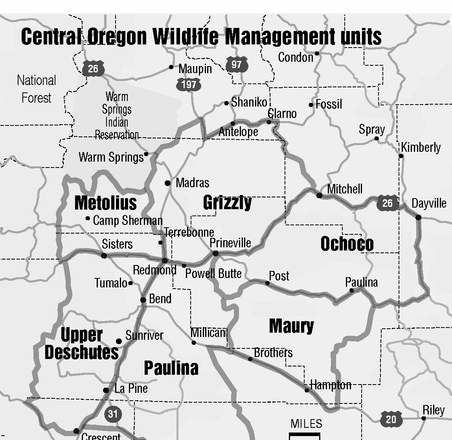Hunting in Central Oregon
Published 5:00 am Thursday, October 13, 2011

- Hunting in Central Oregon
Thanks to rain, snow and generally wet weather, deer hunters enjoyed a fairly successful season the past 12 days in Central Oregon.
Elk hunters are now hoping for more of the same, as the general Cascade bull elk firearm season begins Saturday and runs through Oct. 21 in select Oregon hunting units.
In Central Oregon, Cascade bull elk units include Metolius, Upper Deschutes and West Fort Rock.
“If the (wet) weather continues, I would expect pretty good hunting conditions,” said Steve George, a Bend-based wildlife biologist for the Oregon Department of Fish and Wildlife, who explained that damp conditions can quiet stalking hunters and reduce the chances that they spook big game. “Compared to other years, I talked to quite a few (hunters) who were seeing elk when they were deer hunting. There should be a fair number (of elk) available for rifle hunters. They’ll be scattered out, but I would expect a pretty fair season.”
George said that most elk in the Central Oregon Cascade units are located at middle elevations, where they can find grass and other forage, as well as trees and plants for security and cover.
“If you get too high (in the hills), you tend to run out of grass,” George said. “The grass is actually still green in some spots — that’s where I would look for them.”
George added that elk hunters can generally find more success on the western slope of the Cascades, in units such as Indigo, Dixon and Rogue in southwest Oregon. Those units, from state Highway 58 to the southwest through the Umpqua National Forest, hold some of the most substantial elk populations in the Cascade Range.
With a general Cascade bull elk tag, hunters can hunt in any of those units.
“Most hunters pick an area they are familiar with and stay in that area,” George noted.
The biologist said that the hunter success rate for bull elk in the Metolius, Upper Deschutes and West Fort Rock units is typically about 10 to 12 percent.
Elk population densities are moderate in the Cascade units, but hunters often crowd the portions of those units that are more accessible via roads, according to the ODFW website. For solitude, hunters should seek more-remote wilderness areas in the Cascades.
According to the ODFW, relative to the number of elk, branch-antlered bull opportunity will be good in the Paulina-East Fort Rock Unit, where controlled hunting seasons are set for Oct. 26-30 and Nov. 5-13. But that unit does not hold a high number of elk.
“It’s kind of a spillover unit for those who don’t get their first choice,” George said of the Paulina-East Fort Rock Unit. “Elk are tough to get. Success is in the 3 to 5 percent range. There’s less forage, and not as good of a habitat.”
In the Ochoco District, which includes the Ochoco, Maury and Grizzly units, overall elk numbers and bull-to-cow ratios are below management objectives, according to the ODFW. But the elk are healthy and scattered throughout the units.
The Ochoco, Maury and Grizzly units offer controlled bull elk hunting only, Oct. 26-30 and Nov. 5-13.
The Maury and Ochoco units provide the best opportunities for bagging an animal on public land, while the Grizzly Unit is mostly private land where access can be difficult, according to the ODFW.
Elk tag numbers were reduced this year in the Ochoco and Grizzly units in response to estimates of lower population and lower bull ratios.
In 2010, total hunter harvest and success rates were 82 elk and 26 percent in the Maury Unit, 416 elk and 19 percent in the Ochoco Unit, and 217 elk and 16 percent in the Grizzly Unit.






